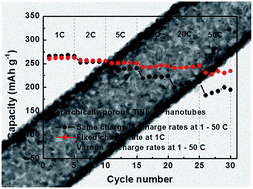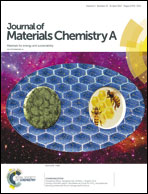Synthesis of hierarchical porous TiNb2O7 nanotubes with controllable porosity and their application in high power Li-ion batteries†
Abstract
Porous transition metal oxides are widely used in energy storage applications owing to their unique physicochemical properties. However, the development of simple synthetic routes using cheap precursors without sacrificial templates still remains challenging. Herein we report a synthesis of hierarchical porous TiNb2O7 nanotubes via dual nozzle electrospinning as a high power anode material for LIBs. The porosity and dimensions of the nanotubes were controlled by varying the molar concentration ratio of Ti/Nb metal precursors to acetic acid and adjusting the degree of formation of Ti/Nb hydroxides in electrospun fibers. The TiNb2O7 nanotubes have a diameter of ∼300 nm with tunable wall thickness and a surface area in the range of 52–151 m2 g−1. Moreover, the nanotubes have a hierarchical porous structure consisting of micropores below 2 nm and mesopores in the range of 5–60 nm in their walls that are connected to the macroscale inner hole with a diameter of 150 nm. The unique structure of the nanotubes enables a high discharge capacity of ∼294 mA h g−1, a stable cycle performance of 86% capacity retention over 700 cycles, and a superior rate capability of ∼230 mA h g−1 at high 50C, which is the highest retention ever reported to the best of our knowledge. Our strategy demonstrates a facile synthesis of hierarchical porous TiNb2O7 nanotubes without templates and their potential as a high power anode material for LIBs.



 Please wait while we load your content...
Please wait while we load your content...